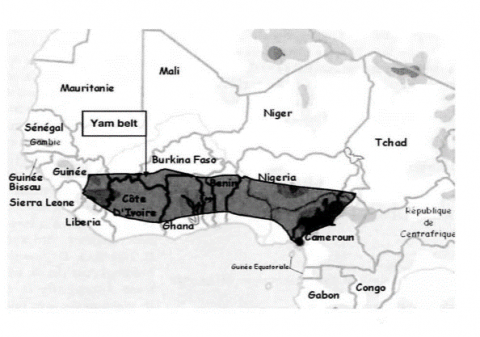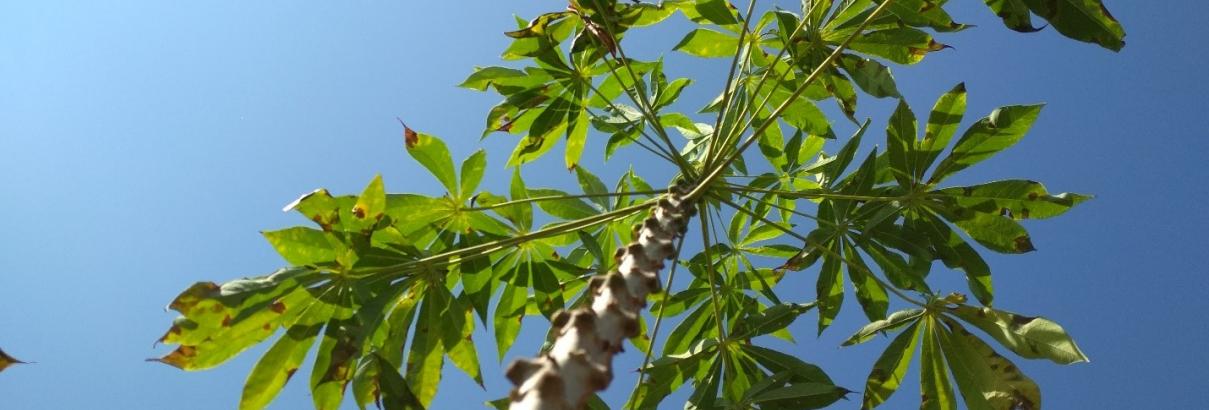Guinea Yams in Benin Republic: Wild Yams Contributing to Domestication Process
Ranjana Bhattacharjee, Tchamba Marimagne and Michael Abberton
International Institute of Tropical Agriculture, PMB 5320, IITA-Ibadan, Nigeria
Guinea yams, consisting of both cultivated and several wild Dioscorea spp., have been described to be resulting from an ongoing process of domestication of wild yams of the Enantiophyllum section by the farmers belonging to different ethnic groups including Nago and Fon in Benin Republic. The two close relatives of main cultivated yam, D. rotundata, in Benin Republic are the savannah species D. abyssinica and the forest species D. praehensilis. Domesticated yam is likely to have derived from one of these two species or from hybridization between them. Many authors hypothesized that high level of diversities of yam varieties exist in West Africa and this is more related to farmer’s ethnic group. In the yam belt of West Africa, the situation is more confusing with the occurrence of a species complex. D. rotundata Poir. and D. cayenensis Lam., also known as Guinea yams. These two species are phenotypically distinguishable with D. rotundata (white yam) having white-fleshed tubers and 6-8 months growth period, and D. cayenensis (yellow yarn) with yellow-fleshed tubers and 8-12 months growth period. In West Africa, D. cayenensis coexists with D. rotundata but not widely cultivated, while it is grown along with D. alata in most of the forest areas in central Africa where D. rotundata is rather limited. Based on morphological characteristics, Miege (1982) proposed Dioscorea abyssinica Hochest ex. Knuth, D. lecardii De Wild., D. liebrechtsiana De Wild., D. praehensilis Benth. and D. sagittifo/ia Pax. as the possible wild progenitors of Guinea yams. Other wild yams that are morphologically related to Guinea yams are D. burkilliana J. Miege, D. mangenotiana J. Miege, D. minutiflora Engl., D. smilacifolia De Wild. And D. togoensis Knuth (Chevalier 1936; Miege 1982). Of all these species, D. burkilliana, D. liebrechtsiana, D. minutijlora, D. mangenotiana, D. smilacifolia, and D. praehensilis are found in rain forests, while the rest are found in the Savannas. Within each ecological zone, these wild species are distributed widely without any geographical isolation.
With the support from CGIAR Research Program on Roots, Tubers and Bananas (CRP-RTB), the team from IITA led by Dr. Tchamba Marimagne made a survey of yam growing regions of Benin Republic to identify the hotspots where wild and cultivated yams are grown to collect leaf samples for DNA analysis and assess genetic diversity to identify the hotspots for further in-situ conservation.
|
Image
 |
Image
 |
Image
 |
West Africa as the major cradle of yam domestication
It is well known that in the forests of West Africa, the domestication process is ongoing. The exact process of domestication is not known, but it is agreed that the highly developed tribal civilizations of West Africa arose in connection with yam cultivation. It is estimated that in West Africa, domestication of yam started as early as 50000 BC, during the Paleolithic era. However, archeologists believe that actual cultivation of yam started about 3000 BC, about the same time when it started in Southeast Asia. The earliest domesticated guinea yams in West and Central Africa are D. rotundata, D. cayenensis, and D. dumetorum. Alexander and Coursey provided a detailed picture of what might have happened during the course of domestication. The succulent tubers of yams were probably encountered many times by primitive food-gathering peoples roaming in the forests. Among the many kinds of yams, they were able to distinguish the poisonous species over time. Domestication might have occurred at their houses where tubers were carried and saved for later consumption, which probably sprouted and developed into new plants. The idea of planting yams could have come from the observation that plants near the home are more convenient to use. It is also believed that the cultivation of yam, which requires a minimum of 6 months, was associated with the establishment of villages. Wild yams are not definitely known, but many cultivars look like the wild D. praehensilis Benth. and other related species such as D. abyssinica. It is highly probable that during domestication of D. rotundata, the most predominant West African white yam, a sporadic exchange occurred between the cultivated and wild forms. Through occasional hybridization with wild ones, the cultivated types were enriched, and their evolution was encouraged.

Recent studies using whole-genome resequencing and statistical modeling have shown that African cultivated guinea yam was domesticated from the forest species and the cultivated yam expanded ca. 2000 generations ago after its domestication.
|
Image
 |
Image
 |
Distribution of guinea yams
The yam belt, where majority of guinea yams are found extends from Cote d’Ivoire to Cameroon, covering about 3,200 kilometers. Yams are usually not found near the seacoast, but their production begins within a few kilometers from the coast and continues for one to several hundred kilometers inland. This is an upland region, often of rolling hills, where rainfall is regular enough through one or more periods to permit the plants to mature. Little is known of the prehistorical distribution of yams outside the Yam Belt. The impression frequently given is that African yams do not grow outside this belt. However, while not as likely to be a staple food, yams are cultivated at least as far north as Senegal, in quantity in Sierra Leone, and to a sufficiently great extent in the Congo. The West African yams/guinea yams occur in limited areas in Tanzania and possibly other regions of East Africa where climatic conditions are suitable.
Outside Africa, the West African yams are very sporadically distributed, and their occurrence in particular regions appears to be due to movement of genetic materials over the years. In the Caribbean, for example, the pattern of cultivation is not regular, whereas very good cultivars of D. rotundata are found in Jamaica, Puerto Rico, and the French West Indies. The African yams are seldom seen in Southeast Asia or on the islands of the Pacific except in New Caledonia, where they were introduced by the French. In several areas of Brazil, they have also become important. Wide distribution of the West African yams appears desirable. Because of their adaptability to areas somewhat drier than those where D. alata is grown and because of the earliness of most cultivars, the African species, especially D. rotundata, should be able to fill a special niche where other species of yams are less successful.
Germplasm collection from yam-belt of West and Central Africa
No collection was ever assembled that was sufficiently extensive to make possible an estimate of the number of cultivars of D. rotundata that exists in West and Central Africa, or even worldwide. The sexual fertility of D. rotundata and D. cayenensis suggests that new seedlings are constantly arising. Although cultural practices are such that one might not expect the establishment and selection of new seedlings, the variation in cultivars throughout West Africa suggests that this indeed has occurred. Normally only a few cultivars are favored in a particular environment, although many more are recognized. Each cultivar occupies a particular niche according to its special characteristics that make it in demand. The intense localization of cultivars, so characteristic of West Africa, adds confusion to the picture. Many authors are of the opinion that the number of varieties of cultivated guinea yam throughout West Africa is between 500 and 2,500.
The Genetic Resources Unit of the International Institute of Tropical Agriculture based in the center of yam-belt in Nigeria has made several yam collection efforts and maintains the largest yam collections in the world with about 3,500 germplasm accessions of West African origin as ex-situ field collection, and about 1,500 accessions as in-vitro collection. The Global Crop Diversity Trust (http://www.croptrust.org) is presently supporting additional collections in West Africa such as in Benin, Togo, Ghana, and Cote d'lvoire, and maintenance of these collections at IITA as ex-situ collections.





